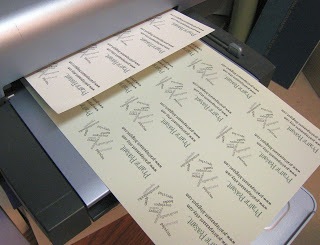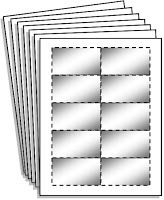Choosing the Correct Materials For Printing Your Own Business Cards
By Andrew Yeung
 |
|---|
| Image found at: prairiepeasant.blogspot.com |
After spending time and energy to carefully design your business card, you will be excited to start handing them out. But, there is one final step in the creation process: printing. Before clicking print you will need to pick out printing materials that meet your business card needs.
Choosing Your Card Stock
It is important choose the appropriate printing materials to increase your cards ascetic. You could print your business card on just regular computer paper, however a more professional approach would be to use business card stock paper. Card stock is thicker than regular paper, making your business cards more sustainable. There is a large variety of card stock available for purchase and choosing the right type for your business card can be overwhelming.
A standard business card is 3.5 by 2 inches. Card stock typically comes in 8.5 by 11 sheets, which allows the card stock to fit in most household printers. When purchasing card stock, you will see a variety of cover weights. These cover weights refer to the thickness of the card stock. The cover weight is the cumulative weight of 500 sheets of card stock. Usually business cards are printed on 80-100 lb stock.
 |
|---|
| Image found at biblevista.com |
When printing your business cards at home, look for card stock manufactured in perforated sheets. Perforated sheets of card stock are blank, but already have each individual card divided out. There will be lines for you to cut along after the cards are printed to insure each card is even in size. Occasionally you can even purchase perforated sheets that are punch outs so you don’t even need to use scissors.
Getting fancy with color and textures
Card stock can be purchased in a variety of textures and colors. The more popular choice for card stock is white or off white with a smooth surface, but thatched or crosshatched textures are two good options to go with as well. if you’re feeling extra fancy, you might even consider card stock with a glossy or metallic finish.
If you are printing double sided cards you can purchase card stock that has color and texture on just one or both sides. Card stock that has color and texture on both sides tends to be more expensive and can quickly eat up your budget, avoid using these stocks if money is an issue.
When printing your business cards we recommend you do a practice run. This will ensure that your printer is lined up properly for the size of the card. When going for a practice run use a cheaper form of card stock for the test print. This will save you from wasting the expensive paper in case there is any type of error. Lastly, we also recommend you shop around and sample different types of card stock to find the type that suits your business’ identity the best.
Have you found a type of card stock you like using? What is holding you back from printing your own business cards? Ask us any questions you have below!
About the Author: Andrew Yeung is president of CompAndSave, a leading online provider of premium printer ink cartridges, including remanufactured and compatible printer ink cartridges. With deals every month and a 100% customer satisfaction, CompandSave provides an easy way for people and businesses to purchase printer ink and accessories.
Learn about CompandSave’s deals and news from the world of printing by following us on Facebook, Twitter, LinkedIn !